AMD Announces FirePro W9100
by Ryan Smith on March 26, 2014 1:00 PM EST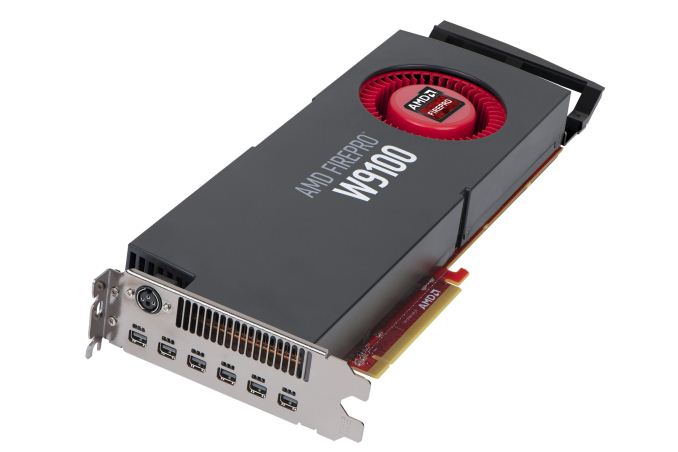
In what’s proving to be a busy week for GPU news, AMD has just wrapped up their webcast announcing their next flagship FirePro product. Dubbed the FirePro W9100, AMD’s latest card is their expected refresh of their FirePro product lineup to integrate the company’s recently launched Hawaii family of processors.
As Hawaii itself was a small but important refresh to Tahiti and the GCN architecture, the same can be said of the FirePro W9100 compared to the FirePro W9000. Other than some gaming-exclusive features such as TrueAudio, Hawaii’s biggest changes were the Asynchronous Compute Engine (ACE) additions that are part of GCN 1.1, the wider 4 primitive geometry pipeline, and of course the overall increase in performance and performance per watt compared to Tahiti. So from a technical perspective W9100 stands to be a relatively straightforward improvement to what W9000 has offered thus far.
| AMD FirePro W Series Specification Comparison | ||||||
| AMD FirePro W9100 | AMD FirePro W9000 | AMD FirePro W8000 | AMD FirePro W7000 | |||
| Stream Processors | 2816 | 2048 | 1792 | 1280 | ||
| Texture Units | 176 | 128 | 112 | 80 | ||
| ROPs | ? | 32 | 32 | 32 | ||
| Core Clock | ? | 975MHz | 900MHz | 950MHz | ||
| Memory Clock | ? | 5.5GHz GDDR5 | 5.5GHz GDDR5 | 4.8GHz GDDR5 | ||
| Memory Bus Width | ? | 384-bit | 256-bit | 256-bit | ||
| VRAM | 16GB | 6GB | 4GB | 4GB | ||
| Double Precision | 1/2? | 1/4 | 1/4 | 1/16 | ||
| Transistor Count | 6.2B | 4.31B | 4.31B | 2.8B | ||
| TDP | ? | 274W | 189W | <150W | ||
| Manufacturing Process | TSMC 28nm | TSMC 28nm | TSMC 28nm | TSMC 28nm | ||
| Architecture | GCN 1.1 | GCN 1.0 | GCN 1.0 | GCN 1.0 | ||
| Warranty | 3-Year | 3-Year | 3-Year | 3-Year | ||
| Launch Price | ? | $3999 | $1599 | $899 | ||
As far as specifications are concerned, it should come as no surprise that W9100 is going to look a lot like AMD’s Radeon R9 290X, their flagship consumer product. W9100 uses a fully enabled Hawaii GPU, so we’re looking at 2816 SPs spread out over 44 CUs. Unfortunately we don’t have the clockspeeds at this time, so we don’t know just how much faster W9100 is on paper versus W9000. However the increase in CUs alone is on the order of 38%, and this doesn’t take into account the improved ACEs and memory bus feeding Hawaii
Speaking of the memory bus, we don’t have the specific width or clockspeeds there either, but we know that AMD has packed W9100 with a ton of memory. 16GB of memory to be precise, which would be as much memory as Hawaii would be able to handle using current generation 8Gb GDDR5 modules. Compared to even W9000, which was relatively large for its time at 6GB, this is huge for a workstation card.
Meanwhile it’s interesting to note that while AMD hasn’t published clockspeed numbers they have published rough performance numbers for both FP32 and FP64. FP32 is rated for over 5 GFLOPS and FP64 is rated for over 2 GFLOPS. The math on that doesn’t work out conclusively – if it’s anything like NVIDIA’s GK110, then there may be additional power requirements that influence performance under FP64 mode – but these numbers point to Hawaii having 1/2 rate FP64 performance. As a reminder 290X was rated at 1/8, so this would mean Hawaii has a much higher rate than what was enabled on AMD’s consumer cards. In fact this would put Hawaii’s native FP64 rate (as a ratio of FP32 performance) as being higher than any other GPU, the next-closest GPU being NVIDIA’s GK110 at 1/3 rate FP64.
Beyond that, we don’t have any further details on the card at this time. W9100 is not launching today – we hear the launch should be soon after – so availability and pricing have not been released thus far. The best we can do is point to the W9000’s launch price of $3999 as some kind of guidance on where it may come in.
Shifting gears for a bit, while AMD was careful on releasing details ahead of the launch of the W9100, they spent some time going in depth into how the card fits into their long-term plans, and what markets they’re pursuing with the card. FirePro continues to pull double duty as AMD’s workstation graphics card and workstation compute card, centered around the capabilities of OpenCL. So AMD is looking to put together a product that can serve both markets well, especially in the case of cross-over applications that make use of both aspects of the card.
Of those aspects, AMD is definitely pushing the compute side harder this time around as opposed to the FirePro W9000 launch in 2012, as the nature of the market has changed. Traditional graphics-heavy professional applications (e.g. AutoCAD) are still as power hungry as ever – if not more so due to the rise of 4K monitors – and meanwhile the amount of compute work being generated by these programs is increasing. This goes for both programs using compute in a more straightforward way, such as running mechanical simulations, and programs leveraging compute for graphics related tasks such as video encoding and image processing. And for both of these tasks AMD is banking on their 16GB of VRAM giving them a performance advantage due to the larger working sets such a large memory configuration can hold.
On that note, AMD has published a few benchmarks ahead of the launch of the card. But as always, these are best take with a grain of salt as they’re almost certainly best-case numbers for their hardware and software stack.
Moving on, along with the announcement of the W9100, AMD has also announced that they will be introducing a new workstation branding initiative to go with the card. Dubbed the “Ultra Workstation” initiative, the program will have 3 tiers of workstations, indicating how many GPUs they have in them and what kind of tasks AMD is recommending for them based on resource requirements and how well major applications scale to that many GPUs.
All of the Ultra Workstation tiers will have a minimum of 32GB of system memory, at least one 8 core CPU, and of course at least one W9100.
Finally, the launch of the W9100 also brings with it a brief update on AMD’s overall transformation in their product offerings, and their current market share. AMD’s share of the professional GPU market is up to 18%, which is still well off of their heyday years ago, but a solid improvement from where they were at the launch of the W9000. To that end professional graphics and compute continues to represent a major growth opportunity for the company, as the other 82% of that market share belongs to NVIDIA, and stealing even a small part of it would significantly improve AMD’s position. Next to their APU offerings – including semi-custom designs and ARM designs – the discrete GPU market for professional graphics is AMD’s final target for significant growth.
Part of that growth will in turn come from essential OEM wins. AMD’s win of the GPU contract for Apples recently launched Mac Pro is a big deal for the company, as you’d expect, as the Mac Pro is a very prestigious win. It remains to be seen just what it means for sales volumes of AMD FirePro products, but it’s a win that AMD can promote to software developers and potential customers alike.


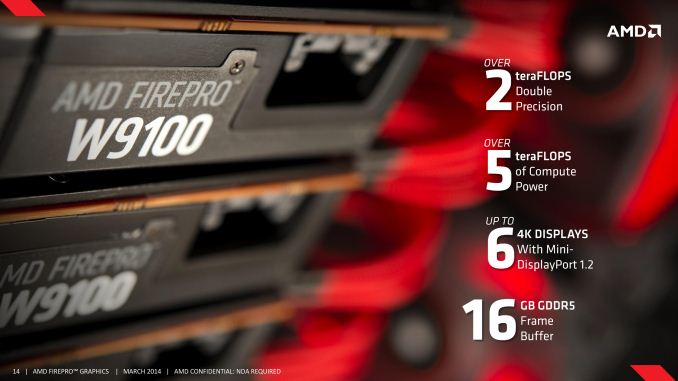
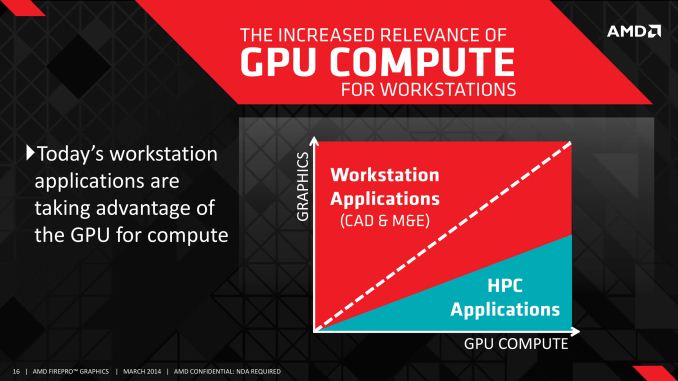

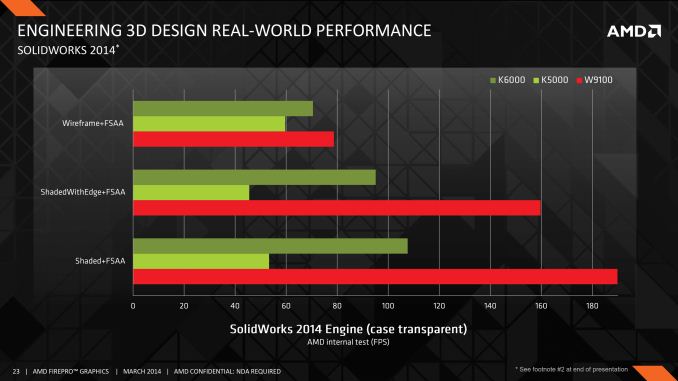
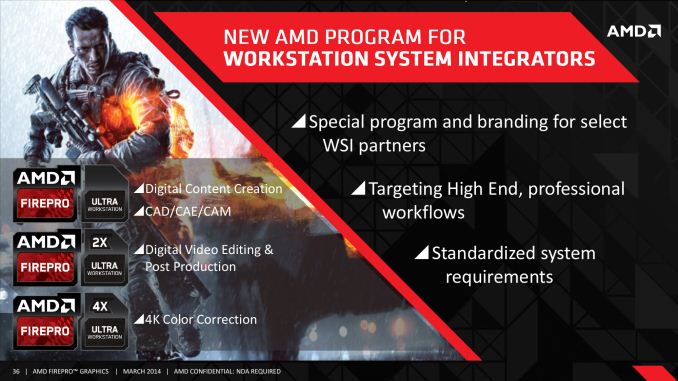
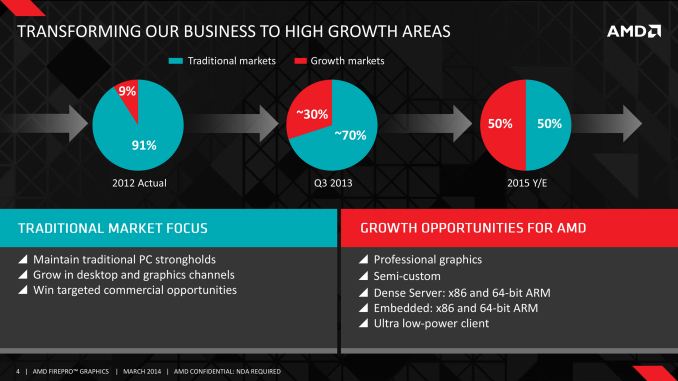
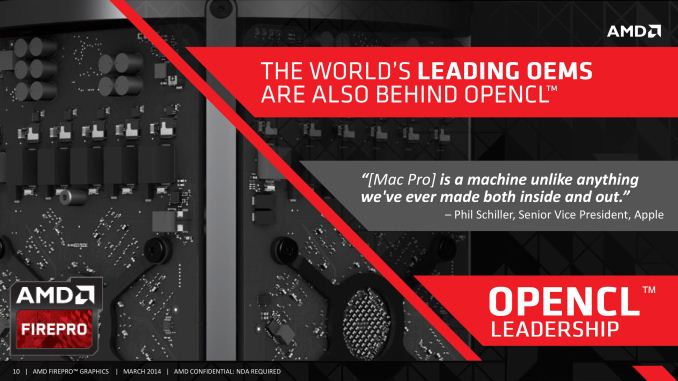








31 Comments
View All Comments
g101 - Wednesday, March 26, 2014 - link
It's true, there may be a technical/cost reason for the higher ratio in the regular desktop cards... Hard to say for sure.g101 - Wednesday, March 26, 2014 - link
The difference in ratio has been confirmed. The reason is unclear, though I agree it's most likely the same reasoning that is behind nvidia's decisions (though nvidia's ratio is much higher (which is worse for the consumer)). This appears to be a more moderate but still marketing-driven decision.JDG1980 - Wednesday, March 26, 2014 - link
Will there be custom AIB versions of this card? We already know from the existing Hawaii cards that that cooler just isn't going to cut it. I doubt that people doing intricate construction on SolidWorks or whatever want their workstation roaring like a jet engine.WithoutWeakness - Wednesday, March 26, 2014 - link
They also don't want to pay for a card that is going to continually throttle itself down to minimum clock speeds. I really don't like AMD's new strategy of listing the maximum boost speeds of their cards as the GPU's clock speed when their cards are unable to maintain that speed with the stock cooler. AMD will either need a redesigned stock cooler or a third-party cooling solution if this card is going to do anything different than the R9 290X does - ramp up to 95C and then ramp up the fan speed and throttle clock speed to stay within thermal requirements.Flunk - Wednesday, March 26, 2014 - link
Based on previous experience they'll all be built by Sapphire and AMD-branded. The stock cooler in the image above will be on all cards. The people who buy these either don't care how loud they are or have taken other measures to quiet down the computer (like sound-proof boxes or locating the box in a server room).JDG1980 - Wednesday, March 26, 2014 - link
These are workstation cards, not server cards. Noise is definitely a factor. A good case with noise dampening can help a little, but not fix the problem completely - and many of these will be in mediocre OEM cases, not a nice Fractal Design R4.I don't understand why AMD didn't just ask Sapphire to use their Tri-X cooler on the cards - we know it works very well on Hawaii, far better than the outdated stock blower.
NicoleMWilson - Friday, March 28, 2014 - link
While I do 3930k and 4930k and ECC memory, they opt for off the shelf consumer cards. Some of these firms have contracts with Ford, Chrysler, Nascar and many other companies. The lure for them of course is price. They are comfortable paying $3500 a machine vs $5500 - $8000. I've tried to push several of my clients toward the AMD FirePro W7000 as I can get these cards for around $500 but they still pass. http://num.to/4871-8450-4883birdiemaker227 - Wednesday, March 26, 2014 - link
Just want to point out to extide that 1/2 rate double precision is much, much larger than 1/8, 1/4 or 1/3. The Radeon cards have been limited on FP64, and for FirePro at 1/3 until now. With this new card from AMD the full potential can be realized at 1/2 rate. It means you get exactly half of the single preicsion rate now, not 1/3 or less.eanazag - Wednesday, March 26, 2014 - link
The margins are clearly different, so i would expect a beefed up ~$4000 version of the consumer card to have a good cooler. Question is: does it stack up against the Titan Z well? I expect it to be more from a cost perspective.I have no use for this today, I can't afford all the 4K displays this card can run. The specs are crazy. I'd hate to be the PCIe bus on the 4 card workstation.
HigherState - Wednesday, March 26, 2014 - link
......or in the same room!!!! Four cards running full tilt would be ear-splitting.